Abstract
Transfer of genetic information from isolated mammalian chromosomes to recipient cells has been demonstrated. Metaphase chromosomes isolated from Chinese hamster fibroblasts were incubated with mouse A9 cells containing a mutation at the hypoxanthine-guanine phosphoribosyl transferase (hprt) locus. Cells were plated in a selective medium, resulting in death of all unaltered parental A9 cells. However, colonies of cells containing hypoxanthine phosphoribosyl transferase (EC 2.4.2.8) appeared with a variable frequency of about 10-6 to 10-7. The enzyme from these cells was indistinguishable from that from Chinese hamster cells, as shown by DEAE-cellulose chromatography and gel electrophoresis, and differed clearly from the mouse enzyme. The colonies, thus, did not result from reversion of A9 parental cells to wild type, but appeared to represent progeny of individual cells that had ingested chromosomes, replicated, and expressed the hprt gene. These colonies differed from each other in stability of expression of the transferred gene.
Keywords: Chinese hamster and mouse fibroblasts, HeLa cells, hypoxanthine phosphoribosyl transferase
Full text
PDF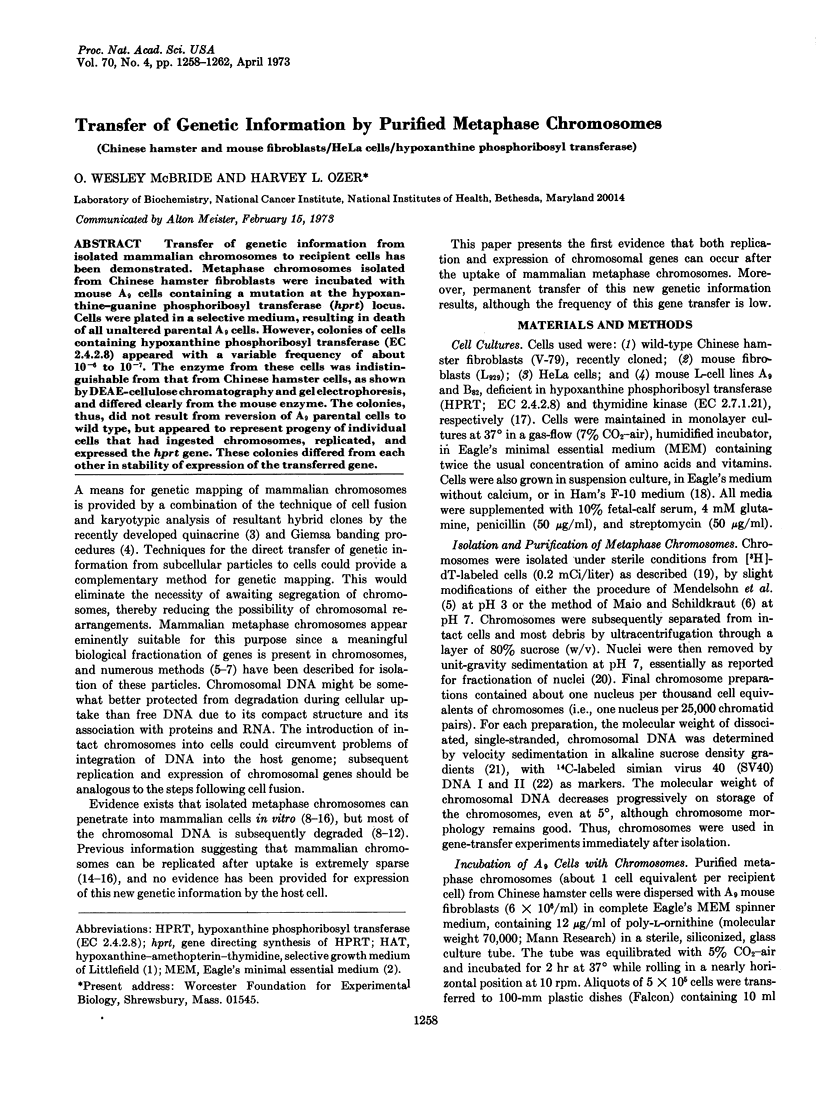
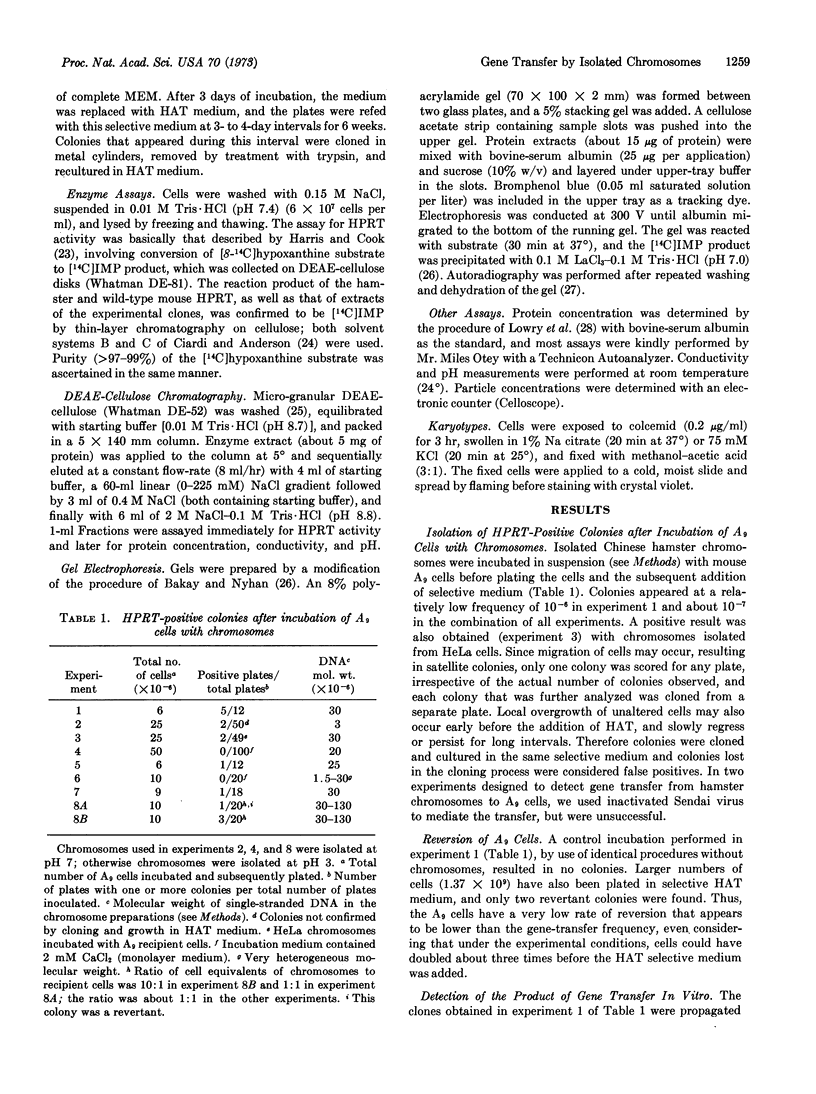
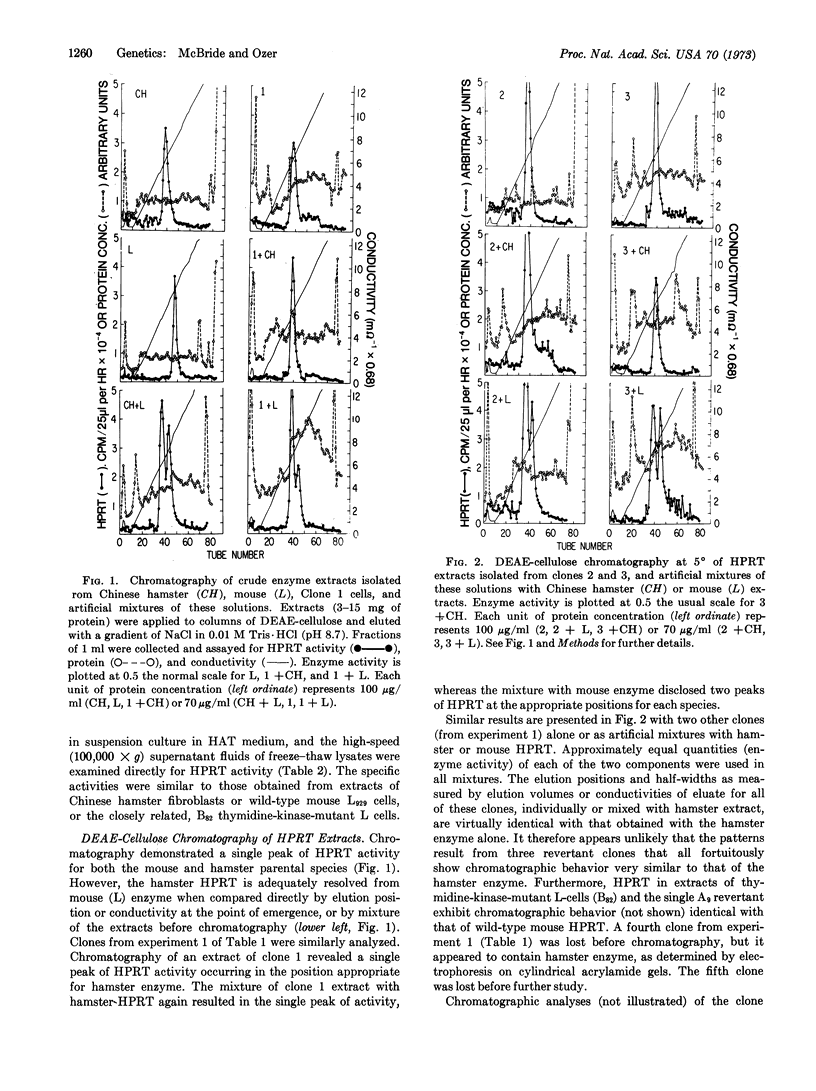
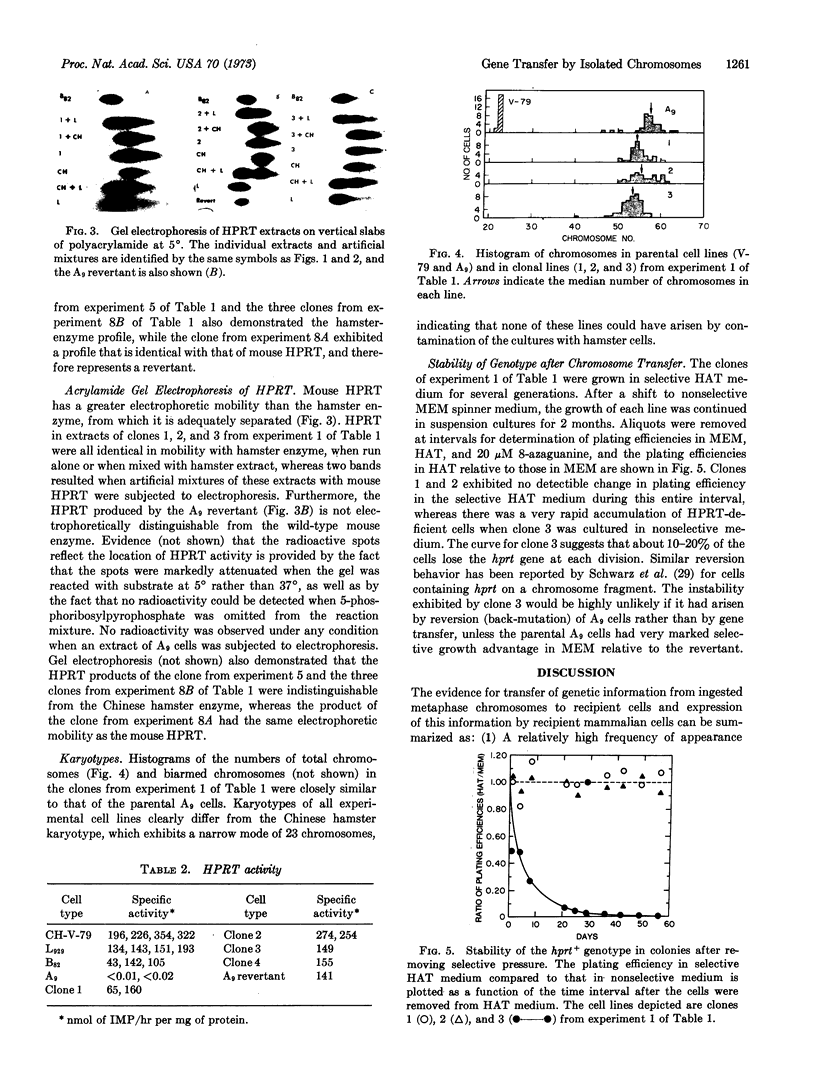
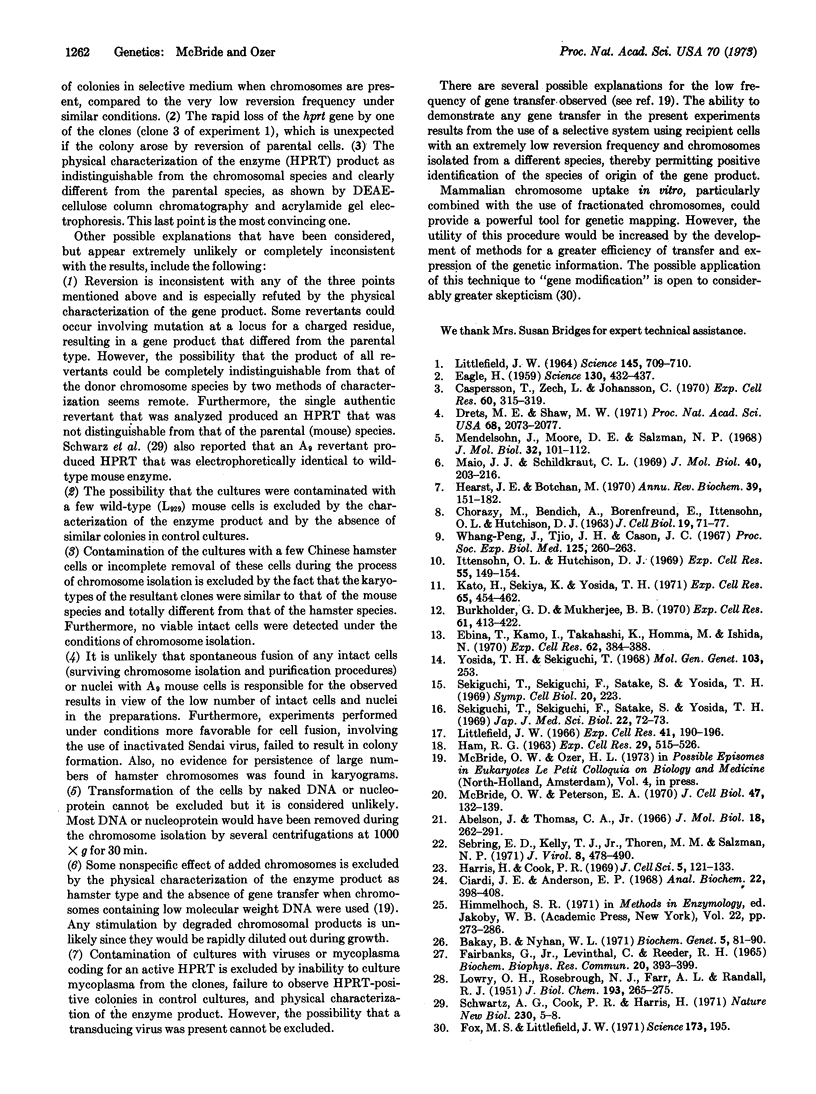
Images in this article
Selected References
These references are in PubMed. This may not be the complete list of references from this article.
- BENDICH A., BORENFREUND E., ITTENSOHN O. L., HUTCHISON D. J. UPTAKE OF MAMMALIAN CHROMOSOMES BY MAMMALIAN CELLS. J Cell Biol. 1963 Oct;19:71–77. doi: 10.1083/jcb.19.1.71. [DOI] [PMC free article] [PubMed] [Google Scholar]
- Bakay B., Nyhan W. L. The separation of adenine and hypoxanthine-guanine phosphoribosyl transferases isoenzymes by disc gel electrophoresis. Biochem Genet. 1971 Feb;5(1):81–90. doi: 10.1007/BF00485733. [DOI] [PubMed] [Google Scholar]
- Burkholder G. D., Mukherjee B. B. Uptake of isolated metaphase chromosomes by mammalian cells in vitro. Exp Cell Res. 1970 Aug;61(2):413–422. doi: 10.1016/0014-4827(70)90466-0. [DOI] [PubMed] [Google Scholar]
- Caspersson T., Zech L., Johansson C. Differential binding of alkylating fluorochromes in human chromosomes. Exp Cell Res. 1970 Jun;60(3):315–319. doi: 10.1016/0014-4827(70)90523-9. [DOI] [PubMed] [Google Scholar]
- Ciardi J. E., Anderson E. P. Separation of purine and pyrimidine derivatives by thin-layer chromatography. Anal Biochem. 1968 Mar;22(3):398–408. doi: 10.1016/0003-2697(68)90282-0. [DOI] [PubMed] [Google Scholar]
- Drets M. E., Shaw M. W. Specific banding patterns of human chromosomes. Proc Natl Acad Sci U S A. 1971 Sep;68(9):2073–2077. doi: 10.1073/pnas.68.9.2073. [DOI] [PMC free article] [PubMed] [Google Scholar]
- EAGLE H. Amino acid metabolism in mammalian cell cultures. Science. 1959 Aug 21;130(3373):432–437. doi: 10.1126/science.130.3373.432. [DOI] [PubMed] [Google Scholar]
- Ebina T., Kamo I., Takahashi K., Homma M., Ishida N. Incorporation of isolated HeLa-S3 metaphase chromosomes into cultured mouse embryo cells. Exp Cell Res. 1970 Oct;62(2):384–388. doi: 10.1016/0014-4827(70)90569-0. [DOI] [PubMed] [Google Scholar]
- Fairbanks G., Jr, Levinthal C., Reeder R. H. Analysis of C14-labeled proteins by disc electrophoresis. Biochem Biophys Res Commun. 1965 Aug 16;20(4):393–399. doi: 10.1016/0006-291x(65)90589-9. [DOI] [PubMed] [Google Scholar]
- Fox M. S., Littlefield J. W. Reservations concerning gene therapy. Science. 1971 Jul 16;173(3993):195–195. doi: 10.1126/science.173.3993.195. [DOI] [PubMed] [Google Scholar]
- HAM R. G. An improved nutrient solution for diploid Chinese hamster and human cell lines. Exp Cell Res. 1963 Feb;29:515–526. doi: 10.1016/s0014-4827(63)80014-2. [DOI] [PubMed] [Google Scholar]
- Harris H., Cook P. R. Synthesis of an enzyme determined by an erythrocyte nucleus in a hybrid cell. J Cell Sci. 1969 Jul;5(1):121–133. doi: 10.1242/jcs.5.1.121. [DOI] [PubMed] [Google Scholar]
- Hearst J. E., Botchan M. The eukaryotic chromosome. Annu Rev Biochem. 1970;39:151–182. doi: 10.1146/annurev.bi.39.070170.001055. [DOI] [PubMed] [Google Scholar]
- Ittensohn O. L., Hutchison D. J. Cytologic manifestations of the phagocytosis of L1210 chromosomes by L1210 cells in culture. Exp Cell Res. 1969 May;55(2):149–154. doi: 10.1016/0014-4827(69)90474-1. [DOI] [PubMed] [Google Scholar]
- Kato H., Sekiya K., Yosida T. H. Uptake of isolated chromosomes by mammalian cells and protective effect of protamine sulfate. Exp Cell Res. 1971 Apr;65(2):454–462. doi: 10.1016/0014-4827(71)90026-7. [DOI] [PubMed] [Google Scholar]
- LITTLEFIELD J. W. SELECTION OF HYBRIDS FROM MATINGS OF FIBROBLASTS IN VITRO AND THEIR PRESUMED RECOMBINANTS. Science. 1964 Aug 14;145(3633):709–710. doi: 10.1126/science.145.3633.709. [DOI] [PubMed] [Google Scholar]
- LOWRY O. H., ROSEBROUGH N. J., FARR A. L., RANDALL R. J. Protein measurement with the Folin phenol reagent. J Biol Chem. 1951 Nov;193(1):265–275. [PubMed] [Google Scholar]
- Littlefield J. W. The use of drug-resistant markers to study the hybridization of mouse fibroblasts. Exp Cell Res. 1966 Jan;41(1):190–196. doi: 10.1016/0014-4827(66)90558-1. [DOI] [PubMed] [Google Scholar]
- Maio J. J., Schildkraut C. L. Isolated mammalian metaphase chromosomes. II. Fractionated chromosomes of mouse and Chinese hamster cells. J Mol Biol. 1969 Mar 14;40(2):203–216. doi: 10.1016/0022-2836(69)90469-0. [DOI] [PubMed] [Google Scholar]
- McBride O. W., Peterson E. A. Separation of nuclei representing different phases of the growth cycle from unsynchronized mammalian cell cultures. J Cell Biol. 1970 Oct;47(1):132–139. doi: 10.1083/jcb.47.1.132. [DOI] [PMC free article] [PubMed] [Google Scholar]
- Mendelsohn J., Moore D. E., Salzman N. P. Separation of isolated Chinese hamster metaphase chromosomes into three size-groups. J Mol Biol. 1968 Feb 28;32(1):101–112. doi: 10.1016/0022-2836(68)90148-4. [DOI] [PubMed] [Google Scholar]
- Schwartz A. G., Cook P. R., Harris H. Correction of a genetic defect in a mammalian cell. Nat New Biol. 1971 Mar 3;230(1):5–8. doi: 10.1038/newbio230005a0. [DOI] [PubMed] [Google Scholar]
- Sebring E. D., Kelly T. J., Jr, Thoren M. M., Salzman N. P. Structure of replicating simian virus 40 deoxyribonucleic acid molecules. J Virol. 1971 Oct;8(4):478–490. doi: 10.1128/jvi.8.4.478-490.1971. [DOI] [PMC free article] [PubMed] [Google Scholar]
- Sekiguchi T., Sekiguchi F., Satake S., Yoshida T. Non-degraded incorporation of highly polymerized DNA and isolated metaphase chromosomes into cultured mammalian cells and replication of the incorporated heterologous chromosomes in the cultured cells. Jpn J Med Sci Biol. 1969 Feb;22(1):72–73. [PubMed] [Google Scholar]
- Whang-Peng J., Tjio J. H., Cason J. C. Reutilization of presumably degraded radioactive label from a chromosomal fraction of homologous and heterologous cells. Proc Soc Exp Biol Med. 1967 May;125(1):260–263. doi: 10.3181/00379727-125-32064. [DOI] [PubMed] [Google Scholar]
- Yosida T. H., Sekiguchi T. Metaphase figures of rat chromosomes incorporated into mouse cells. Mol Gen Genet. 1968;103(3):253–257. doi: 10.1007/BF00273696. [DOI] [PubMed] [Google Scholar]




